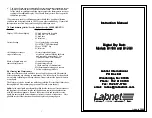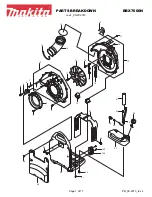
Photoelectric Effect Apparatus
Model No. AP-8209
7
®
Alignment Screws
The Mercury Light Source has two small alignment screws on opposite
corners of its base. The Photodiode enclosure has slightly larger alignment
screws installed along the midline of its base.
Mount the Enclosures on the Base
Place the Mercury Light Source enclosure on the base so that the
alignment screws go into the matching alignment holes on the
base, and the position indicator arrow on the side of the enclosure
is aligned with 0 mm on the edge of the base.
Place the Photodiode enclosure on the base so that the alignment screws go
into the matching alignment holes on the slot in the base, and the position
indicator arrow on the side of the enclosure is aligned with 400 mm on the
edge of the base
Connect Cords and Cables
Note:
Before connecting any cords or cables, be sure that both switches on
the h/e Power Supply are in the OFF position.
• Connect the power cord from the Mercury Light Source enclosure into the
receptacle labeled “POWER OUTPUT FOR MERCURY ~220V” on the side
of the h/e Power Supply.
• Connect the special DIN-plug-to-DIN-plug power cable between the port on
the back of the Photoelectric Effect Apparatus labeled “POWER SUPPLY” and
the port on the h/e Power Supply labeled “POWER OUTPUT FOR APPARATUS”. Screw the
knurled rings on the plug ends of the cable onto the threaded section of each port.
• Connect the special BNC-plug-to-BNC-plug cable between the port marked “K” on the Photodiode
enclosure and the port marked “K” on the back of the Photoelectric Effect Apparatus. Screw the
knurled rings on the plug ends of the cable onto the threaded section of each port.
• Connect the red banana-plug patch cord between the port marked “A” on the
Photodiode enclosure and the port marked “A” on the back of the Photoelectric
Effect Apparatus.
• Connect the blue banana-plug patch cord between the port marked with the ‘down
arrow’ (symbol for GROUND) on the Photodiode enclosure and the port marked
with the ‘down arrow’ (GROUND) on the back of the Photoelectric Effect
Apparatus.
• Connect the power cord between the port on the side of the h/e Power Supply
labeled “POWER INPUT ~110V” and an appropriate electrical outlet (Note: For
the 220 volt model, connect the cord between the port labeled “POWER INPUT ~220V” and an
appropriate electrical outlet.)
Alignment
screws
Alignment
holes
Alignment screws
Alignment holes
Note: These three
cords will be
disconnected during
calibration. You do
not need to turn off
the power from the
Power Supply when
you disconnect and
then reconnect these
three cords








































